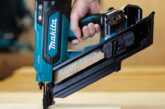
Makita explains how dust management can be made easier with dust extractors and tools that integrate to automate extraction when the tool is in use.
There are two broad types of construction dust. One is inhalable dust, which is made up of visible, airborne particles generated, for example, when cutting wood. This form of dust can irritate and damage the skin and eyes and can also be breathed into the airways and deposited in the respiratory tract. However, these particles are usually captured and cleared naturally by the body’s mucus when they are inhaled.
The second type, respirable dust, can be much more damaging as it consists of finer, often invisible particles that can penetrate deep into the lungs. This includes Respirable Crystalline Silica (RCS), the particles of which are 100 times smaller than the average grain of sand and is commonly generated from drilling, cutting or breaking concrete, brick and stone. When inhaled, RCS can cause scar tissue to form in the lungs, in turn leading to silicosis. Frequent or prolonged exposure to respirable dust can also cause Chronic Obstructive Pulmonary Disease (COPD) and has been linked to cancer. There is no ‘safe’ level of exposure and frequent contact with even minute amounts of dust can have a serious long-term impact on health. It is estimated that around 500 people die every year due to occupational exposure to RCS.
However, these occupational lung diseases are preventable and having a dust extractor and tools that integrate together to operate as one, is one way to help achieve this. Many dust extractors have an ‘auto-start’ setting that means it runs automatically when a corded tool connected via the power take-off is activated. However, many professionals are now using cordless tools for the simplicity, flexibility and safety they offer, but this does mean the extractor typically has to be activated manually.
This issue can be solved by selecting tools with wireless connectivity capabilities such as those that feature the Makita Auto-start Wireless System (AWS). This connects the tool to AWS compatible, dust extractors using Bluetooth to deliver the same automatic operation. A Bluetooth chip is fitted into the port on compatible tools and paired effortlessly with the dust extractor. Up to 10 AWS tools can be connected paired to one extractor, where users simply reconnect the dust hose when switching between power tools as required therefore reducing time wasted on manually powering multiple tools on and off.
M Class is the minimal legal requirement set by the HSE when working on sites where concrete, mortars and man-made wood products are laboured and a number of Makita’s M Class machines are suitable for use for both wet and dry cleaning. For example, the VC2211MX1 22-litre dust extractor is suitable for processes involving wood dust and silica dust and also includes power take-off to streamline the operation of the tool and extractor. Its compact design makes it easy to carry and transport the extractor and use in smaller work areas. 30L, 32L and 42-litre M-Class Extractors are also available to accommodate larger volumes of dust extraction where required.
In addition, there are also adaptors that allow dust extractors without built-in wireless capabilities to function automatically with cordless tools. This includes the Makita 191A40-6 and 199804-6 adaptors for extractors with 110v and 240v power take-off respectively. The adaptor unit plugs into dust extractors that feature a power take off socket and connects with AWS enabled cordless tools via Bluetooth, to provide automatic operation.
To find out more about Makita’s range of dust extractors and AWS enabled tools visit https://makitauk.com/products/dust-extraction-sets







